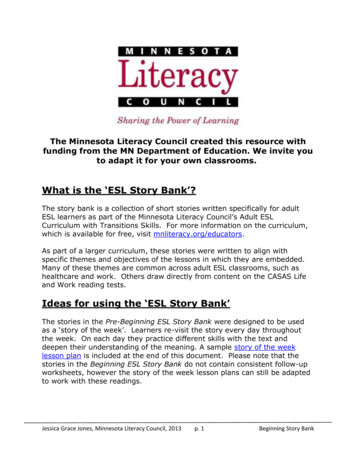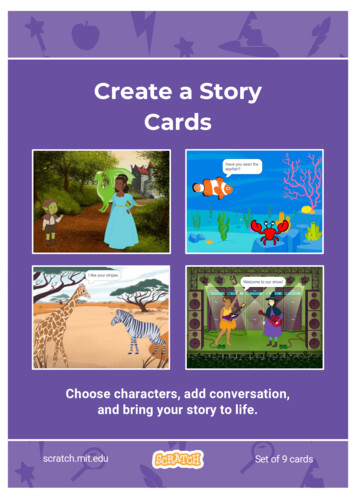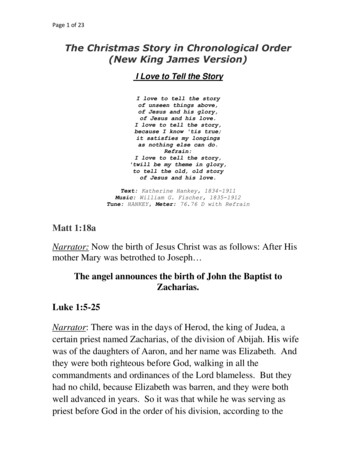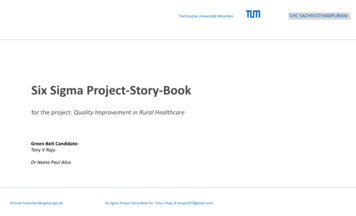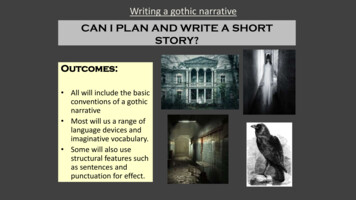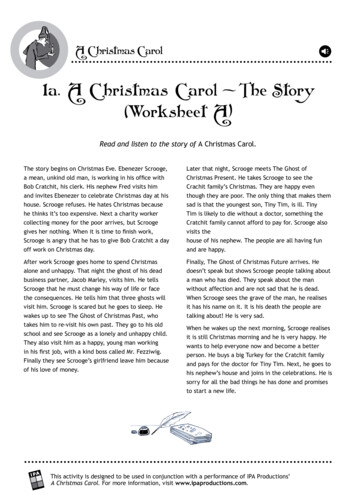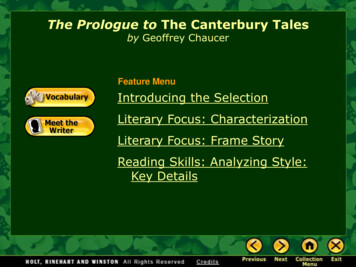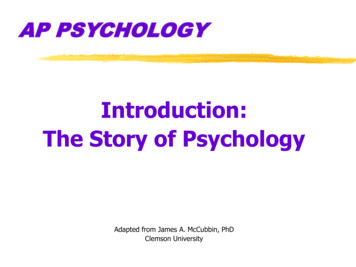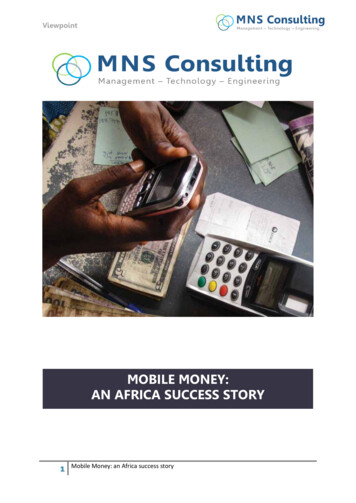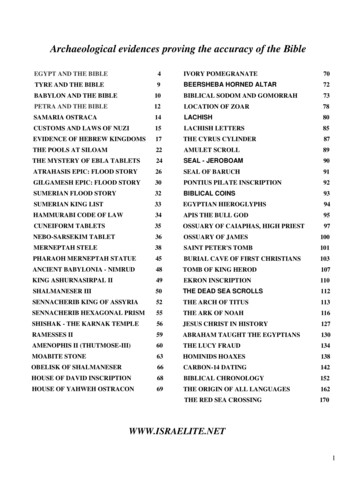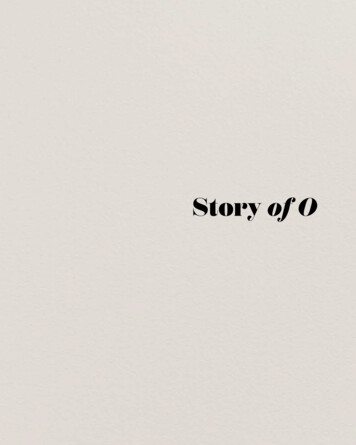
Transcription
Story of O
Story ofDrawings byNatalie FrankO
ContentsHistory00Story00Natalie Frank in conversationwith Lawrence Weschlerregarding her drawingsinspired by the Story of O00Drawings00Biographies00List of Works00
HistoryNatalie FrankStory of O—an erotic novel that shocked andacknowledge their relationship, instead writingaroused millions—was published in 1954it as if they were strangers.under the pseudonym Pauline Réage. ManyIn 1955, O won the Prix des Deux Magots,readers suspected the book, with its frankwhile the book’s publisher Jean-Jacques Pau-descriptions of bondage and desire, to have beenvert (who had previously published Sade’s com-authored by a man. Upon reading O, Frenchplete works) was charged with obscenity. Thephilosopher Albert Camus announced that afirst English-language edition of the book waswoman could not have written it: Women, heissued in 1965 by Olympia Press, infamous forsaid, did not possess such erotic imaginations—its own publication of Lolita, The Ginger Man, andnor were they capable of such immorality. How-Naked Lunch, as well as pornography for sailors.ever, in 1994 the French intellectual DominiqueDuring the1960s, O became the most-read con-Aury (born Anne Desclos, 1907–1998) revealedtemporary French novel outside France.her identity as the author in an interview withIn the decades that followed, however, fem-the New Yorker.inists viewed the book as pornography and aAury was an editor of the French literarysymbol of oppression of women’s equality, edu-publications Les Lettres Françaises and La Nou-cational and employment discrimination, andvelle Revue Française. She was the only womanlimited access to birth control and abortion. Onto sit on the reading committee of the leadingAmerican college campuses, the book was seizedFrench publisher Gallimard, where she workedand ceremonially burned. Feminist writer andas an editor and translator for the last fifty yearscritic Andrea Dworkin embodied both sides ofof her life. She was also one of the first womenthe polemic regarding O. In her book Womanto write openly and explicitly about domination,Hating from 1974, she wrote: “What lifts thissubmission, and sex.fascinating book above mere perversity is itsO is a love-letter of seduction. Aury wrotemovement toward the transcendence of the selfthe book in an attempt to intellectually woo backthrough a gift of the self . . . to give the body, toher lover Jean Paulhan, the head of Gallimard,allow it to be ravaged, exploited, and totally pos-whom she feared was straying. Like Camus,sessed can be an act of consequence, as if it isPaulhan believed that women were not capabledone with love for the sake of love.” However, byof writing erotica—but Aury’s letters changedthe end of her discussion on O she calls it “a storyhis mind. He encouraged her to turn her note-of psychic cannibalism, demonic possession, abooks into a novella, and he wrote the preface tostory which posits men and women as being atthe first edition of O himself—though he did notopposite poles of the universe—the survival of7
one dependent on the absolute destruction of thewhich contained information about conventionother.”events and works by feminist artists. This riftDuring the Feminist Sex Wars of the 1970samong feminists persists, with many believ-and 80s, opposition grew against activists likeing that the fight against pornography is key toDworkin and journalists and writers such aspreventing sexual assault and rape, though theSusan Brownmiller and Robin Morgan (whocampaign itself has brought together sex work-helped form Women Against Pornography iners and anti-censorship crusaders advocating1978). Sex-positive feminists, led by scholarsfor freedom of expression.Carol Vance, Ellen Dubois, Ellen Willis, andAury’s friend, the French erotic novel-Gayle Rubin, wanted to move beyond debatesist Régine Desforges, tells the story that whenabout pornography and violence and focus onAury was young, she enjoyed strolling throughsexuality apart from reproduction. These fac-Les Halles dressed as a prostitute. The Story oftions came to a head at the Barnard ConferenceO allows the reader similar imaginative oppor-on Sexuality in 1982, with protests and picketstunities. The book’s complex acknowledgment offrom anti-pornography groups, threats of pulledwomen’s sexual lives—filled with fantasy, desire,funding from Barnard College administration,and pain—makes this book revolutionary, andand confiscation of the conference’s Diary,accounts for its enduring legacy89
StoryNatalie FrankO’s story is about the birth of a woman’sjoin her in bed; O takes her turn and becomesimagination and the possibilities of hera submissive with a woman for the first time.character. Her journey of transcendence is oneWhile at Samois, O reflects on her past, whenof choice and desire, physical and emotionalshe courted submissive young women to be herliberation, intertwined with fantasies of domi-lovers. O persuades Jacqueline to join her, René,nance and submission.and Sir Stephen in their return to Roissy; Jac-O is taken by her lover René to Chateauqueline’s younger sister, Nathalie, joins them asRoissy, a castle in France, and initiated into thewell.rites of submission. René later gifts her to hisIn the final scene, O is dressed as an owl andstepbrother Sir Stephen and, while under hisgiven to The Commander, who has her displayedtutelage, O begins to cultivate a submissive ofin the center of a masked ball. A little girl andher own, a model named Jacqueline.boy approach O with fascination, touching andAt Samois, a house of submission run by anprodding her. After O’s return to Roissy, thereolder woman named Anne-Marie, O is preparedare several variations of an ending: in one, O isfor the brand and irons that will mark her asabandoned by Sir Stephen. In another, she com-Sir Stephen’s. Each night, Anne-Marie drawsmits suicide after he leaves her.straws to determine which girl in her house will11
ConversationNatalie Frank in Conversation with Lawrence Weschlerregarding her drawings of the Story of OLawrence Weschler Under what circum-LW Beyond that, what was your response to thestances did you first come upon the Story of O?book at the time?Natalie Frank I think I was fifteen when INF Shock and awe. I just had never heard peoplefound it, 1994 or so . . .speak and interact that way. I didn’t know thatliterature could sound like that—it was obviousthat this was a “serious book.” I knew that it wasLW On your parents’ bookshelf ?controversial enough to have been written underNF In a bookstore. My parents’ shelves rangeda pseudonym. I liked that idea of anonymity whilefrom cooking to FDR. Sex wasn’t talked about indoing something performative and aggressive,the South.which is I guess what I do now (laughs), minusthe anonymity.LW Where were you growing up?LW Were you aware of the feminist wars about porNF Dallas and Austin, Texas. My mother wasnography roiling around that time?involved in Planned Parenthood, my father isNatalie Frank inConversationwithLawrence Weschlera pediatrician. I was quite an exhibitionist as aNF Not at all. I knew the book was controversial,child and though my parents would never telltook risks, and like anything avant-garde, wasme that something was right or wrong, my fathercausing trouble, in the best way. I’d started look-would just say do it in your room with the dooring at the German and Austrian Expressionistsclosed; my mother was horrified. (laughs) I thinkjust before I found O, and was very aware of theI have always had an active imagination; that’sprecedent of scandalous art and how historicallyprobably why I was drawn to O.important it is.I had read D. H. Lawrence’s Women in Love,the first book I fell in love with—it was very eroticLW And did the book seem transgressive?to me—the Story of O was floating nearby. I carried O around everywhere, even on airplanes,NF No, because I didn’t feel that there was anyand remember that reading it in public was asstigma attached; there was only my naïveté,thrilling as just reading it. I was blushing con-much like O’s. I easily saw myself in her. Istantly. It was unlike anything I had ever experi-remember the rush of excitement: how excitingenced. I think it was the first erotic book I readit was that a woman’s imagination produced this,that was written by a woman.that she had vocalized her own desires, and thatthis narrative came from her imagination. O has13
always read to me as a story of freedom. When Iceiling from a pole, his penis four inches fromThere’s a sense of the existential doom of humanlearned that Dominique Aury—who wrote undermy head, which the ladies all thought was hys-nature in Elective Affinities. And even though Othe name Pauline Réage—had written the bookterical. I took it very seriously. It was just draw-feels exciting and liberating and full of power, itpartially in response to the claim that womening to me. I’d take these drawings to school tohas a similar denouement. And yet, O does thor-didn’t have erotic imaginations, the book madediscuss with my art teacher, and the head of theoughly transform.even more sense.department labelled me a pornographer andtried to keep me from hanging them. Eventually,LW Before we go any further, could you perhapshe relented and said I could hang nude women. Itgive us a brief survey of your development as anwas probably also around this time that I pickedartist, beyond that garage, doing life drawings asNF No, not at all. I think I saw a clear differenceup Linda Nochlin’s essay “Why Have There Beena young teenager.between the things that went on in books, whichNo Great Women Artists?” from 1971. Let’s justare fictions, and the things that went on in thesay, books have always helped me to put thingsNF Well, at fifteen I went to the Slade in Londonworld.in perspective!for a summer program, and that proved a pivotalLW Were you frightened by the material?experience. I went again at seventeen. It’s whereLW To what extent did your attitude play off of theLW Do you find that reading the Story of O now,I was first introduced to the School of London—traditions of women in the South? The two coun-you realize that there’s all kinds of stuff you didn’tDavid Hockney, Peter Blake, Paula Rego, Stan-tervailing archetypes of Southern women: on theget when you were fifteen?ley Spencer, R. B. Kitaj, Lucian Freud—and fellin love with their way of having the body at theone hand, the whole antebellum and Klan idea ofwhite women embodying the pure flower of threat-NF At fifteen, the book for me was full of imag-center of narration, with doses of magic realismened virtue, but also the notion of brash Southernination. The only sex that I knew about at themixed with the extreme cruelty of everyday life.women loving to hang out with rodeo cowboys.time were football players screwing cheerleadLW After which, for undergraduate studies youNF My mom actually did run a cattle ranchbook has never been just about sex to me—sexattended Yale. Majoring in art?that she had inherited from her Russian cow-always seemed like the vehicle for expressionboy father in East Texas, where the KKK in factand growth as a woman.ures. She drew a lot on literature.It was in her studio, in 2009, that she recommended that I look at the Grimms tales. She’sNF Yes. And I actually met Paula Rego there. Wedone a lot of work with fairy tales, but she’s in herbecame quite close, writing letters, and I startedeighties and said, “I’m not going to get around todoing these, but you should.” And so . . .been persuaded that there was ever any purityLW Did your attitude toward the book change overto visit her in London. She’d come to my stu-in women or in flowers, in the South especially.the years?dio, I’d go to hers. A few years back I posed for aI grew up knowing that choice and speech werewomen that were fleshed out, usually from Lila,and then these graphic, menacing, cartooned fig-ers before the morning bell in pickup trucks. Thishad been active during her lifetime. I’ve neverPaula Rego, Inspectiondrawing. My face ended up in a Jane Eyre litho,LW Wait a moment, let’s catch up with your owncareer. Did you go on to get a Master’s at Yale?rights that women continually had to fight for.NF Maybe in my twenties, it felt more like a liter-and then on one of her British postage stamps.My great aunt, Hermine Tobolowsky, was theary exercise of a woman wanting to transgress.She has been a tremendous influence. Early on,mother of the Texas Equal Rights Amendment,I read the same two books every year and O isshe showed me what it was like to be a self-pos-NF No, undergrad. My first year out, I worked forand I was very aware, through her work, that upone of them.sessed, fearless, feminist artist. Her work ethic isNan Rosenthal at The Met. After which I did a Ful-almost inhuman! And I always admired how shebright in Oslo studying Edvard Munch, and usedused her work to interweave the personal andthe work I made that year to apply for my MFA,the political. She’s made a lot of work about abor-and I went to Columbia for the next two years.until 1967 women couldn’t even inherit property!Around the time I was reading O, I was takingLW What’s the other one?figure drawing classes in a woman’s garage withsixty-year-old women, drawing from the nudeNF Goethe’s Elective Affinities. And, actually, theretion. She uses a model, Lila, who’s a stand-in forAnd began showing my last year of Columbia, inmodel. My mother accompanied me becauseare strange similarities between the two.herself, and she’s constantly dealing with narra-2006.I was so young, and the first model was a Gre-The Goethe is abstract, people comingtives of familial negligence, respect and love andcian god named Alexander who hung from thetogether and apart and changing each other.romantic relationships. There were always real14LW Showing what?15
had proved gruesome, so that it was something I“the grotesque sublime”—Sleeping Beauty, or Briarteller, writing in the 1690s. She wrote incrediblemight want to check out.Rose as she was originally known, as a rape victimstories, emphasizing female authorship and aand so forth. Would that be a fair characterization?postmodern sense of identity.LW So, you started reading these things and . . .Natalie Frank, End of Romance, oil on canvas, 2005.80 x 65 inches.NF Sure, although that way of seeing things justLW So you’re deep in fairy tales, especially in theirNF I became just transfixed, obsessed. And atseems like life to me. When I eventually put aoriginal sexualized and grotesque forms, and allthis point I was still doing a show of paintingsbook of them together, illustrating Jack’s trans-of this will soon to be leading to this most recentevery year. I had never done a body of drawings.lations, people would say, “How are these rele-project of yours, where, in effect, you are going toI think another reason Paula’s such an inspira-vant? They’re so outlandish,” but it’s actually justbe taking on the Story of O and seeing it, too, as ation is because she has such a strong belief in herwhat goes on every day. We couldn’t be living infairy tale. But in the meantime, there was a littleown talents. I never thought I could draw, and Ia more insane time! I’d approached them with ainterlude where you involved yourself with balleri-also couldn’t imagine being able to draw from myfeminist lens, focusing on the women in the sto-nas and S & M dungeons.imagination.ries, their transformations, and how their nar-But I had this huge book of Jack’s and I wouldratives reflected life at the time. Women puttingNF Yes. They seem related to me: contortions ofdip into it for fun. In the meantime, I’d also beentheir own traumas and triumphs into these oraland storytelling through the body.reading Marina Warner and Maria Tatar and hadtales—which were later written down—was arealized that the tales were a point in literaturewily act of subterfuge. We need to return to thisLW You’ve been citing literary antecedents. Withwhere women exercised a very strong voice: howidea of resistance, now more than ever.your ballerinas, are you likewise tapping into suchall of the stories began as women’s oral tales, andMy next book with Jack will draw on thethat the Brothers Grimm had adjusted them fortales of Madame d’Aulnoy, a baroness who waspoetics, later cleaning them up to increase sales,the first and most famous literary feminist fairypainterly influences as Degas?NF Yes, the Degas who speaks about dancersand simply put their name onto them. But as I say,I was reading Jack’s unsanitized versions, someas “les petits rats.” Or when he was going intobrothels and drawing and making monotypes ofNatalie Frank, The Stammerer, oil on canvas, 2007.62 x 72 inches.NF Paintings mainly. Women and domestic inte-of which embody a nineteenth-century patriar-riors with a magic realist sense of dread. Theychal attitude, but others are proto-feminist andDegas is one of my favoritewere fleshy and quickly painted.aspirational. It’s clear they were originally toldartists, there’s a violence inand collected by women. I thought: Oh my god,his work that is inseparableLW And it was a few years after that, that Regothese unexplored dark areas that women havefrom beauty.says you should look at Grimms’ Fairy Tales.been existing in, they were all implicit, maybe,My dancers, I portrayedwhores that mimicked the poses of his dancers.in the whitewashed, Disneyfied versions we grewalone. These were life-sizedNF Indeed. So, I came home and ordered Jackup with, but they really have not been excavatedpaintings in which there wasZipes’ unsanitized edition of Grimms and startedand visualized. And I thought, I really want to doa lot of empty space, figuresto read.this; I wanted to bring those voices back to life.feel like they’re suffocating,And I did so, in a kind of secret production, forthe brush work encroachingLW Up until that moment, how had you imaginedover two years, and then one day I had Claire Gil-on them.the Grimms fairy tales?man from the Drawing Center over and she said,“We should talk about a show.”LW And for you all this sug-NF I had no idea what they were, actually, only aLW As somebody who was watching you do thosegested . . . ?vague recollection of Disney movies. I knew Pauladrawings at the time, I remember once havinghad worked a lot from fairy tales and her sourcesdescribed the results to somebody as instances of1617
quite surprising to find all of this harrowingLW Did getting the permission become part of thetwistedness in your work.performance?NF But really, why is that surprising?NF Everything was a performance. Most peoplewere masked. One submissive agreed to showLW Let’s just say that I would not be sur-his face—one of his fetishes was even being pho-prised to find out that the person who didtographed unmasked while in session, becausethese paintings and drawings was, well,none of his coworkers, as you said, would haveshall we say, way more Goth than you.suspected this of him.NF Right. But those statements imply thatLW Have you learned things from that experiencewomen somehow can’t draw on their imag-that you were surprised by?ination. That women have to representNatalie Frank, All Fur III, gouache and chalk pastelon paper, 2011–14. 30 x 22 inches.outwardly what they are inwardly, whichNF I learned about what they did. I learned theredenies integrity. And I don’t see the two aswas no sex involved but that the eroticism ofbeing incongruous. I don’t think that youwhat they did was much more powerful, whichcan decipher someone’s art through theirobviously relates to my O. I learned how sensi-person. It happens in the studio with me,tive the relationship is between the dominatrixoften coming from men. Women aren’tand submissive. And I learned the personal sto-surprised that other women have com-ries of why these women came to be doing whatplicated interior lives that might not bethey do—which were all radically different. Someexpressed on their exterior.Natalie Frank, All Fur I, gouache and chalk pastel onpaper, 2011–14. 30 x 22 inches.were economic or financial, most of them werepersonal.LW I’m not sure the phenomenon is gendered; INF Probably self-portraiture. It seems like acan think of a few male artists where I’ve beengood representation of an artist at work.similarly surprised. But be that as it may, nextyou found yourself venturing into dungeons.LW his might be as good a place as any to pickNF I would never have done that. I have noLW And what about yourself ?interest in that because it perpetuates a powerNF You keep coming back to that. (laughs) I feltdynamic that feels too much a part of everydayvery comfortable with these women and, backlife, one that subjugates women. I’m interestedup an issue that’s so funny for many of yourNF At the time I was drawing superheroes,to your earlier point, these were women thatin turning the tables.friends—not funny, maybe—but it is the wayseemingly related to the Grimms’ tales andyou would see walking down the street and notLW You do understand that we’re about to startthat out in the world you strike one as a com-was interested in what a female superhero-have the faintest clue about their lives—that justtalking about the Story of O? (laughs)pletely well-adjusted, sane person, in controline would look like. And I thought: dominatri-sounded very Southern—about what they do forof yourself, and so forth.ces! I’ve always been interested in exchangeswork. I love that idea of this mystery. You neverNF Yes! But O and Aury turn the tables so dra-of power, especially when sex and violencereally know what’s inside of someone and whatmatically, both women are calling the shots, evensurround the body. And so I visited quite atheir imagination can engender. That is power!if it appears otherwise—that’s why this book wasNF So do you!few S & M dungeons, photographing womenLW I understand, but you can interview meand their submissives.later, now I get to interview you. And so it isso controversial. Men have been writing aboutLW Would you have had a similar reaction ifrepressing women for centuries; this was some-you had portrayed male dominance and femalething else entirely, it was revolutionary.submissives?1819
where men are dominant andsubmissive. The way that the men are mere toolsLW So, a happy little tale. (laughs) It’s not that shewomen submissive—the wholefor her own . . .finds herself exactly.NF Yes.NF No, but she loses herself while coming intothing is a send-up of pornography, deploying every trope andcliché you’d expect in a B-movieof an S & M sex castle; however,her own.Susan Sontag wrote about the differencesLW . . . and in some way, she’s in charge.it is all told from the vantage ofbetween art and pornography, using O as ana woman—our heroine, O—withNF The book is written in different sections andinstance of the one and not the other. O devel-women’s desire being explored intowards the end, her lover takes her out of Roissy,ops as a woman, she has an interior life, she feelsthis way for the first time in liter-and she’s given to his stepbrother, Sir Stephen.more and more alive. The sex and violence in theature. She is there by choice andIn the third section of the book, O reveals thatbook are a means for her “ascent through deg-every step along the way involvesshe is bisexual and in previous relationships withradation,” as Sontag explains—this was such aher consent and her desire.young women delighted in assuming the role ofrevolutionary little book because it was the firstthe dominant, which she does to a degree witherotic book written by a woman about sex, vio-LW When was the consent regis-Jacqueline, as well as Nathalie. Another type oflence, and women’s interior lives and their trans-tered in the plot?female relationship is explored when she is withformative desires. It also essentially explored athe older Anne-Marie, wherein all eroticism isspectrum of relationships that challenged con-removed from sex.ventional norms. And it is such a send-up ofNF They tell her pretty soon aftershe arrives at the château whathappens there and that she canpornography because ultimately O developsemotionally and intellectually, which doesn’tLW And how does it end?leave at any time.Natalie Frank, Domina I, 2017. Oil on canvas. 65 x 76 inches.occur in pornography.Anyway, the first hundredNF Ambiguously is how it ends. In one version, SirLW By way of introduction, could you just give meand fifty pages are very erotic, describing theStephen abandons her, passing her on to some-LW But even in the meta story, wasn’t it an instancea quick sense of the Story of O, as if I’d never readopulent interiors, the firelight and velvet. O’sone else, and in another she requests permissionof a woman, “Pauline Réage,” writing all this forit.taken through scenes of sex and beatings andto kill herself. There seems to be so much confu-the pleasure of a man, her lover?lives in a cell in this château, interacts with othersion about what role she wants to play that shewomen, isn’t supposed to lift her gaze to look atcan no longer exist. On one hand, she becomesNF She wrote it for herself to show that this isthe men whose faces are partially obscured, anda Christ-like figure, her self-erasure becomes awhat she and women can do. Women can seduceshe is tremendously excited by these activities.type of martyrdom, as if she were destined tothrough means other than with sex—which isNF You haven’t?!LW Of course, I have. I’m just trying to . . .NF Oh, right, as if one had never read it.And, when I read it this time, the scenes Ibe taken apart, becoming symbolic in the pro-the great humor about this book—superficiallyWell: Once upon a time there was a woman,chose to depict were not this or that other sexcess. On the other hand, it feels as though sheit revolves around sex, but it was written to flaunta young girl named O, who didn’t know what toact, but rather how she experiences the pleasuremight have lost her ability to choose, through thisthe much more powerful eroticism—of the mindexpect.of the power exchanges that go on. And there isextensive process of sublimation, albeit one sheso much humor!chose initially. I think Aury wants it to be ambig-LW You know, of course, how there has been a hugeLW What kind of person was she?NF Naive. She is taken by her lover to the Châteauuous, and this feels very postmodern and allowsdebate in feminism about whether the book’s goodLW So, you’re keying in on the dialectic of thethe text to rest on the edges of real life/allegory.for women or not. What’s been your take on that?power of the powerless or the dominance of theRemember that she also wrote this book as aRoissy, where she’s undressed and bathed byseries of letters to her lover, and this loss of selfNF I think it’s complicated. Ultimately, it’s notwomen and wrapped in a cloak and brought outis a big part of love.pornography, where actual women are used inand told what will be happening. It’s a dark placethe making of images; it is literature, art. In the2021
a great rage among women as to how we arecompletely alone but feel like I’ve been talkingallowed to represent ourselves, the ability to leg-and interacting with people all day.islate our own bodies, and an increasing visibil- ity in us speaking up. In Trumpworld, the rightswe have successively claimed since the 1950s feelLW So tell us a little about some of the drawingstenuous at best.you’ve completed so far, the ones you have lined upalong that wall over there.LW You were saying before that after havingobserved the dungeon scenes and so forth, yourNF Well, they begin with her fully formed, drawnsense of the book this time was very different. Howin a very realistic, whole way, in the car with herso?lover, who’s. . .erotic freedom is celebrated. As women, this isNF It was heightened. The eroticism of the begin-LW Ironically, a second ago you described her asa right that has long been denied to us, by menning felt a lot more erotic. The scenes of domina-naive and unformed, but that drawing of her isand by other women.tion and submission—which I think I understoodindeed the most composed we are ever going to seebetter because now I had actually watched themher. She thinks she’s fine.Need caption?author’s intent—and in the heroine’s journey—LW It’s interesting that we happen to be having thisfirsthand—were both more terrifying but alsoconversation in the very wake of the Harvey Wein-more alluring.NF Exactly. (laughs) Just wait until she’s frag-stein scandal and all the others that seem to be fol-In addition, the ending of the book felt likemented. She’s going to love it! (a line deliveredlowing it, and the #MeToo movement. What do youa very accurate representation of how it feels towith singular mock relish) She’s in the car withmake of all that?be an artist. One becomes so involved in fictionsher lover, she has her gloves on and, under hisNF I highlighted paragraphs and scenes I thoughtand dynamics and theatrical performances thatinstruction, she’s taking her panties off so herwere important. In many of the drawings, partsNF I am so thrilled by and appreciative of theby the end of the day one’s self is almost erased,thighs can feel the leather, and it’s the beginningof the figures sometimes become transparent.ways in which women are speaking up in manywhereas the interior life one has endured andof her initiation into the S & M world. Her lover,So the idea of boundaries and personal spacefields about harassment and abuse and it seems,created has triumphed.by comparison, is fragmented, and has a doubleand what’s real and what’s not are constantlyset of features. But, really, the men in all thesecollapsing.finally, they are beginning to be heard.* Let’s beabsolutely clear, though—with these drawings, ILW That makes it sound like the artist is a submissive.am not condoning violence towards women, orthe repressive levels of patriarchy. I am advocat-Natalie Frank, Domina I, 2017. Oil on canvas. 65 x 76 inches.images are beside
the first book I fell in love with—it was very erotic to me—the Story of O was floating nearby. I car-ried O around everywhere, even on airplanes, and remember that reading it in public was as thrilling as just reading it. I was blushing con-stantly. It was unlike anything I had ever experi-enced. I think it was the f
